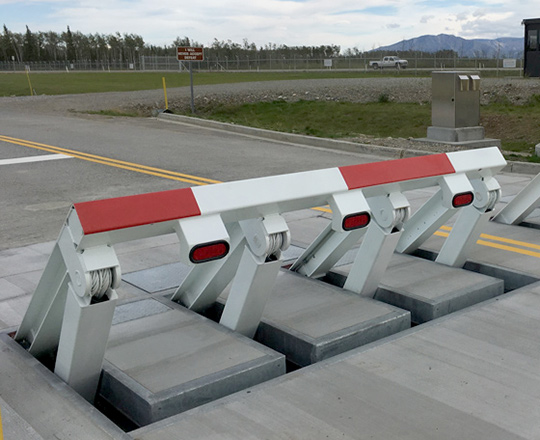Some Ideas on Wedge Barriers You Should Know
Wiki Article
The Greatest Guide To Wedge Barriers
Table of ContentsSome Known Details About Wedge Barriers The Of Wedge Barriers

14 and the surface 12 to which the obstacle 10 is safeguarded might be made from concrete - Wedge Barriers. 2, the barrier 10 is mounted to or consists of an anchor or subframe (e. g., support 30 shown in FIG. 2 )safeguarded underneath the surface 12. The bather 10 might be bolted to the anchor or protected to the support by various other mechanical bolts. In the illustrated embodiment, the barrier 10 consists of a wedge plate 16, which includes a part that is considerably parallel with the surface area 12 when the obstacle 10 remains in the withdrawed setting. Simply put, vehicles or individuals might pass over the obstacle 10 when the obstacle 10 remains in the withdrawed setting and experience minor elevation loved one to the surface area 12 while on the obstacle 10. As reviewed thoroughly listed below, when the obstacle 10 is in the deployed setting, the wedge plate 16 is held and supported in an elevated position by a lifting device of the barrier 10. Furthermore, the elements 18 might be bolted or otherwise mechanically paired to one an additional. In this fashion, repair service or substitute of one or more components 18 may be streamlined and structured. That is, repair work or substitute of single elements 18 may be done faster, easily, and expense efficiently. FIG. In particular embodiments, the support 30 may be a steel frame including plates, light beams(e. g., I-beams ), and/or various other frameworks that are protected within the foundation 14, which may be concrete. At the surface 12, a top side 28 of the anchor 30 might be at least partly revealed , thereby allowing the accessory of the barrier 10 to the anchor 30. g., threaded openings)in one or more beam visit this site of lights or plates of the support 30 may be exposed to the surface 12. In this way, bolts 32 or various other mechanical bolts may be used to protect the obstacle 10 to the anchor 30. As the barrier 10 is placed to the surface area 12 of the foundation 14, collection of debris and other material beneath the obstacle might be decreased, and components of the bather 10 may not be exposed to below grade atmospheres. As indicated by referral numeral 52, the training system 50 includes elements got rid of under the wedge plate 16. For instance, the elements 52 under the wedge plate 16 may consist of an electromechanical actuator, a web cam, one or even more camera surface areas, etc. In addition, the training system 50 includes a spring assembly 54
The springtime pole 58 is paired to a cam(e. g., cam 80 shown in FIG. 4) of the training device 50. The springtimes 60 disposed about the spring pole 58 are kept in compression by spring sustains 62, consisting of a taken care of spring assistance 64. That is, Recommended Reading the fixed springtime support 64 is taken care of about the foundation 14 et cetera of the bather 10.
The Ultimate Guide To Wedge Barriers
The remaining force applied to the cam webcam deploy release wedge plate 16 may be provided offered an electromechanical actuator 84 or other actuator. The spring assembly 54 and the actuator 84(e. Wedge Barriers. g., electromechanical actuator)might operate with each other to convert the cam and raise the wedge plate 16.
As mentioned over, in the released position, the wedge plate 16 my company serves to block accessibility or travel beyond the barrier 10. The barrier 10(e. g., the wedge plate 16 )may block pedestrians or lorries from accessing a home or pathway. If an automobile is taking a trip in the direction of the deployed wedge plate 16(e. For example, in one situation, the security legs 86 might be prolonged duringmaintenance of the barrier 10.
Report this wiki page